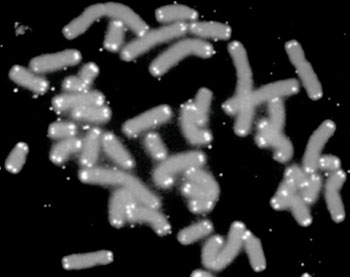Experimental Cancer Drug Disrupts Telomerase Function
By LabMedica International staff writers
Posted on 13 Jan 2015
Cancer researchers have published a detailed study of the potential chemotherapeutic drug 6-thio-2'-deoxyguanosine (6-thio-dG), a potent inhibitor of the enzyme telomerase.Posted on 13 Jan 2015
A telomere is a region of repetitive nucleotide sequences at each end of a chromosome, which protects the end of the chromosome from deterioration or from fusion with neighboring chromosomes. Telomere regions deter the degradation of genes near the ends of chromosomes by allowing chromosome ends to shorten, which necessarily occurs during chromosome replication. Human telomeres possess a single-stranded DNA (ssDNA) overhang of TTAGGG repeats, which can self-fold into a G-quadruplex structure. Overexpression in cancer cells of the enzyme telomerase, which adds length to telomeres, allows them to divide in perpetuity. Telomerase is activated in most human cancers and is critical for cancer cell growth.

Image: Micrograph showing human chromosomes (grey) capped by telomeres (white) (Photo courtesy of the US Department of Energy Human Genome Program).
Investigators at the University of Texas Southwestern Medical Center (Dallas, USA) studied the nucleoside analogue 6-thio-2′-deoxyguanosine (6-thio-dG), which is recognized by telomerase and is incorporated into de novo-synthesized telomeres. This results in modified telomeres, leading to telomere dysfunction, but only in cells expressing telomerase. The investigators worked with cancer cell cultures and with a mouse lung cancer xenograft model.
They reported in the December 16, 2014, online edition of the journal Cancer Discovery that 6-thio-dG, but not 6-thioguanine, induced telomere dysfunction in telomerase-positive human cancer cells and hTERT-expressing human fibroblasts, but not in telomerase-negative cells. Treatment with 6-thio-dG resulted in rapid cell death for the vast majority of the cancer cell lines tested, whereas normal human fibroblasts and human colonic epithelial cells were largely unaffected. In A549 lung cancer cell-based mouse xenograft studies, 6-thio-dG caused a decrease in the tumor growth rate superior to that observed with 6-thioguanine treatment. In addition, 6-thio-dG increased telomere dysfunction in tumor cells in vivo. Unlike many other telomerase-inhibiting compounds, 6-thiodG did not cause serious side effects in the blood, liver, or kidneys of the treated mice.
“We observed broad efficacy against a range of cancer cell lines with very low concentrations of 6-thiodG, as well as tumor burden shrinkage in mice,” said senior author Dr. Jerry W. Shay, professor of cell biology at the University of Texas Southwestern Medical Center. “Since telomerase is expressed in almost all human cancers, this work represents a potentially innovative approach to targeting telomerase-expressing cancer cells with minimal side effects on normal cells. We believe this small molecule will address an unmet cancer need in an under explored area that will be rapidly applicable to the clinic.”
Related Links:
University of Texas Southwestern Medical Center










 (3) (1).png)



